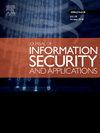基于跳跃连通密集块和边缘损失的端到端图像隐藏模型
IF 3.7
2区 计算机科学
Q2 COMPUTER SCIENCE, INFORMATION SYSTEMS
Journal of Information Security and Applications
Pub Date : 2025-07-30
DOI:10.1016/j.jisa.2025.104180
引用次数: 0
摘要
端到端图像隐藏是一种新的隐藏范式,它将一个图像隐藏到另一个图像中。然而,现有的端到端图像隐藏模型仍然没有很好地平衡不可感知性和计算复杂度。为了解决这一问题,本文提出了一种基于跳跃连通密集块和边缘损失的端到端图像隐藏模型。首先,利用密集块和跳跃连接设计了一种新型的隐藏/提取网络;其次,定义边缘损失来衡量预测分布与实际分布在细节上的差异。在隐蔽通信中,发送方需要向训练好的隐藏网络输入一个掩蔽图像和一个隐藏图像,就会产生一个与掩蔽图像在视觉上没有区别的容器图像。对于接收者,利用提取网络可以从容器图像中恢复隐藏图像。实验结果和分析证明了所提模型的有效性,与现有端到端图像隐藏模型相比,所提模型生成的容器图像和隐藏图像具有更好的视觉质量,PSNR为43.96 dB, SSIM为0.987,有效容量最高为17.7458 bpp。它在大容量隐蔽通信中具有广阔的应用前景。本文章由计算机程序翻译,如有差异,请以英文原文为准。
An end-to-end image hiding model based on skip connected dense block and edge loss
End-to-end image hiding is a new hiding paradigm which hides an image into another image. However, the existing end-to-end image hiding models still do not have a good balance between imperceptibility and computational complexity. To deal with the problem, a novel end-to-end image hiding model is proposed based on skip connected dense block and edge loss in this paper. Firstly, a new type of hiding/extraction network is designed by utilizing dense block and skip connection. Secondly, edge loss is defined to measure the difference in detail between the predicted distribution and the real distribution. In a covert communication, the sender needs to input a cover image and a hidden image to the trained hiding network, and a container image which has no visual difference from the cover image will be produced. For the receiver, the hidden image can be recovered from the container image by using the extraction network. Experimental results and analysis demonstrate the effectiveness of the proposed model, compared with the existing end-to-end image hiding models, the container image and the hidden image generated by the proposed model can achieve better visual quality as PSNR 43.96 dB and SSIM 0.987, and the effective capacity is the highest 17.7458 bpp. It has broad prospects for high-capacity covert communication.
求助全文
通过发布文献求助,成功后即可免费获取论文全文。
去求助
来源期刊

Journal of Information Security and Applications
Computer Science-Computer Networks and Communications
CiteScore
10.90
自引率
5.40%
发文量
206
审稿时长
56 days
期刊介绍:
Journal of Information Security and Applications (JISA) focuses on the original research and practice-driven applications with relevance to information security and applications. JISA provides a common linkage between a vibrant scientific and research community and industry professionals by offering a clear view on modern problems and challenges in information security, as well as identifying promising scientific and "best-practice" solutions. JISA issues offer a balance between original research work and innovative industrial approaches by internationally renowned information security experts and researchers.
 求助内容:
求助内容: 应助结果提醒方式:
应助结果提醒方式:


